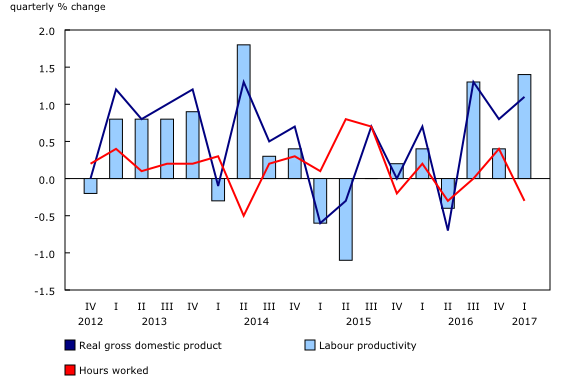Labour productivity, hourly compensation and unit labour cost, first quarter 2017
Archived Content
Information identified as archived is provided for reference, research or recordkeeping purposes. It is not subject to the Government of Canada Web Standards and has not been altered or updated since it was archived. Please "contact us" to request a format other than those available.
Released: 2017-06-02
First quarter 2017
1.4% 
(quarterly change)
Labour productivity growth accelerates in the first quarter
Labour productivity of Canadian businesses rose 1.4% in the first quarter—the largest gain since the second quarter of 2014 (+1.8%) and the second time in three quarters that productivity growth exceeded 1.0%.
Despite fewer hours worked in the first quarter, business output continued to grow rapidly.
The real gross domestic product (GDP) of businesses rose 1.1% in the first quarter, up slightly from the 0.8% gain the previous quarter. Every major industrial sector except agriculture and forestry increased production in the first quarter. Both goods-producing and service-producing businesses increased their pace of production.
Hours worked to produce goods and services in the business sector edged down 0.3% in the first quarter, following a 0.4% gain the previous quarter. The decline in hours worked in service-producing businesses (-0.7%) more than offset a 0.8% increase in hours worked in goods-producing businesses. The decline was widespread in service-producing industries, led by administrative services (-2.6%), finance and insurance (-2.0%) and arts and entertainment (-1.9%). Retail trade fell 0.9%, while hours worked were unchanged for wholesale trade.
The productivity of service-producing businesses rose 2.0% in the first quarter and was the main factor in overall productivity growth. In contrast, productivity in goods-producing businesses rose 0.9%.
Finance and insurance (+3.3%), wholesale trade (+3.0%), retail trade (+2.8%) and manufacturing (+2.0%) were the main sources of productivity growth among industry sectors in the quarter. Administrative services (+3.1%), transportation and warehousing services (+2.6%) and real estate services (+2.5%) also contributed to the gain.
In the United States, labour productivity of businesses fell 0.4% in the first quarter, after two consecutive quarterly increases. This was the largest decline since the fourth quarter of 2015 (-0.5%). The real GDP of US businesses (+0.1%) rose at a much slower pace in the first quarter than the previous quarter (+0.6%), while hours worked (+0.5%) rose more quickly than the fourth quarter (+0.1%).
Unit labour costs fall
Higher productivity for Canadian businesses (+1.4%) in the first quarter surpassed the gain in average compensation per hour worked (+1.0%). As a result, the labour cost per unit of output for Canadian businesses fell 0.4%, following a 0.4% increase the previous quarter.
Among service-producing businesses, hourly compensation increased 1.3% in the first quarter, while it was virtually unchanged in goods-producing businesses (+0.1%). Only the mining, oil and gas extraction; public services; accommodation and food and beverage services; and information and cultural services industries declined in the first quarter.
Following two quarters of depreciation, the average value of the Canadian dollar relative to the US dollar was up 0.8% in the first quarter. As a result, unit labour costs in US dollars for Canadian businesses rose 0.5% following two quarters of decline.
By comparison, the unit labour costs of American businesses rose 0.8%, twice the pace of the previous quarter.
Note to readers
Revisions
With this release on labour productivity and related measures, data were revised back to the first quarter of 2016 at the aggregate and industry levels. These revisions are consistent with those incorporated in the quarterly gross domestic product (GDP) by income and expenditure and monthly GDP by industry, published on May 31, 2017.
This release also incorporates the new 2016 benchmark data on provincial and territorial labour productivity and related measures, published on May 19, 2017.
Productivity measure
The term productivity in this release refers to labour productivity. For the purposes of this analysis, labour productivity and related variables cover the business sector only.
Labour productivity is a measure of real gross domestic product (GDP) per hour worked.
Unit labour cost is defined as the cost of workers' wages and benefits per unit of real GDP.
All the growth rates reported in this release are rounded to one decimal place. They are calculated with index numbers rounded to three decimal places, which are now available on CANSIM.
All necessary basic variables for productivity analyses (such as hours worked, employment, output and compensation) are seasonally adjusted. For information on seasonal adjustment, see Seasonally adjusted data – Frequently asked questions.
Next release
Labour productivity, hourly compensation and unit labour cost data for the second quarter will be released on September 6.
Products
The System of Macroeconomic Accounts module, accessible from the Browse by key resource module of our website, features an up-to-date portrait of national and provincial economies and their structure.
The Methodological Guide: Canadian System of Macroeconomic Accounts (13-607-X) is available.
The User Guide: Canadian System of Macroeconomic Accounts (13-606-G) is also available. This publication will be updated to maintain its relevance.
Contact information
For more information, or to enquire about the concepts, methods or data quality of this release, contact us (toll-free 1-800-263-1136; 514-283-8300; STATCAN.infostats-infostats.STATCAN@canada.ca) or Media Relations (613-951-4636; STATCAN.mediahotline-ligneinfomedias.STATCAN@canada.ca).
- Date modified:


